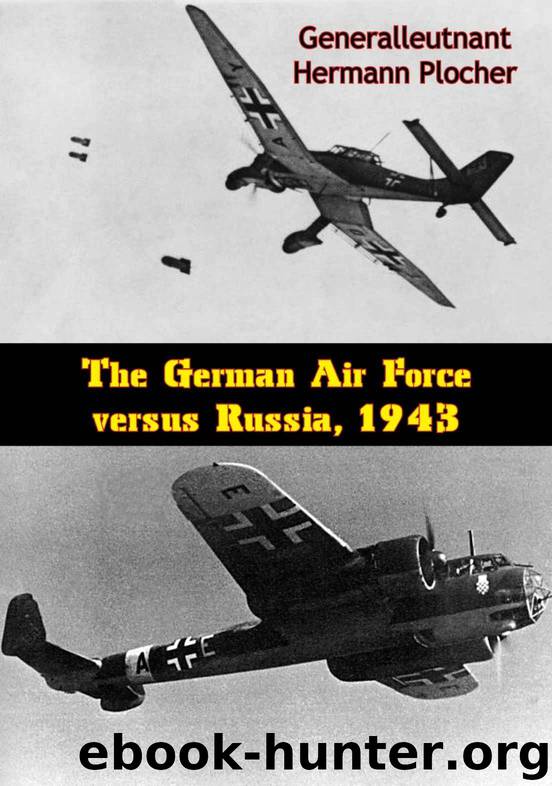The German Air Force versus Russia, 1943 by Generalleutnant Hermann Plocher

Author:Generalleutnant Hermann Plocher [Plocher, Generalleutnant Hermann]
Language: eng
Format: azw3
Publisher: Eschenburg Press
Published: 2017-06-28T04:00:00+00:00
The Luftwaffe in the Far North: Norwegian and Barents Seas and the Murmansk Front
Finnish Front
The Finnish Front was the northern cornerstone of the German European defense system, the extreme northern flank position of the Eastern Theater of Operations, which at the same time protected the rear of the Norwegian Front. The total frontage of approximately 840 miles was about two-thirds as long as the entire Eastern Front (Leningrad to the Crimea), and large sectors of it were defended by systems of strong points.
In the south-eastern sectors of this zone the terrain was heavily wooded and quite swampy, while in the north-east it was devoid of trees and in many places consisted of rocky tundra.{479} Weather conditions varied greatly. On 1 November 1943, for example, temperatures ranged from 0° to 46° Fahrenheit. In the northern areas there were the characteristically long arctic nights in the summer. Mud seasons were inconsiderable.
In the field of military economy the nickel works of Kolosjoko near Petsamo were important, and accounted for 32 percent of the European nickel production.{480}
The population of Finland totalled 3,800,000 persons, but military operations on a large scale were impossible because of a great lack of communications. With only a single railroad extending from north to south as far as Rovaniemi, and an eastward branch line running to Kandalaksha still under construction, plus a single good north-south road from Helsinki to Petsamo, the area was completely lacking in routes capable of carrying enough traffic to support an offensive. In contrast, the Russians had the highly satisfactory Murmansk railroad route. Operations were therefore conducted primarily in the form of patrol and raiding party activities, with flank battles and some more active fighting for particularly important roads.
Because of its broad extent, the front in this area nevertheless tied down strong German forces. The Twentieth Mountain Army had a strength of 176,800 men, all especially selected for their ability to withstand the harsh rigors of the local natural conditions. Its divisions were at full strength, fully equipped, trained under peacetime conditions, and ably led.{481}
Conditions for air operations were generally unfavorable, and the terrain offered few possibilities for the construction of airfields.{482}
After the defensive battles in this area in the spring of 1942, the war on the Karelian Front dragged slowly onward. It was characterized by positional warfare, carried out on a small scale. In an estimate of the situation by Generaloberst Alfred Jodl, Chief of the Wehrmacht Operations Staff, which was received at Finnish General Headquarters on 2 January 1943:
“...the Wehrmacht High Command considered it possible that the Russians toward the end of winter might seek a decision in an attack against the front held by the Twentieth Mountain Army, probably in the XIX Mountain Corps sector (Murmansk sector) and possibly in combination with an amphibious operation by the Western Allies on the Arctic coast....”
“Information had been received again and again in Finland concerning an impending large-scale Soviet offensive against the Finno-German front. The Commanding General, Twentieth Mountain Army,{483} believed these reports and ordered the
Download
This site does not store any files on its server. We only index and link to content provided by other sites. Please contact the content providers to delete copyright contents if any and email us, we'll remove relevant links or contents immediately.
| Africa | Americas |
| Arctic & Antarctica | Asia |
| Australia & Oceania | Europe |
| Middle East | Russia |
| United States | World |
| Ancient Civilizations | Military |
| Historical Study & Educational Resources |
Red Famine: Stalin's War on Ukraine by Anne Applebaum(2816)
Chernobyl by Serhii Plokhy(2440)
Midnight in Chernobyl by Adam Higginbotham(2391)
The House of Government by Slezkine Yuri(2105)
Midnight in Chernobyl: The Untold Story of the World's Greatest Nuclear Disaster by Adam Higginbotham(2079)
Red Shambhala by Andrei Znamenski(2073)
The Gulag Archipelago (Vintage Classics) by Aleksandr Solzhenitsyn(1987)
All the Kremlin's Men by Mikhail Zygar(1962)
From Cold War to Hot Peace by Michael McFaul(1942)
Red Notice by Bill Browder(1933)
Putin's Labyrinth(1902)
The Future Is History by Masha Gessen(1822)
From Russia with Lunch by David Smiedt(1797)
A People's Tragedy by Orlando Figes(1770)
The Romanovs by Simon Sebag Montefiore(1723)
How to Tame a Fox (and Build a Dog): Visionary Scientists and a Siberian Tale of Jump-Started Evolution by Lee Alan Dugatkin & Lyudmila Trut(1681)
Putin's Labyrinth: Spies, Murder, and the Dark Heart of the New Russia(1664)
The Lost Spy by Andrew Meier(1634)
Art and Revolution by John Berger(1607)
